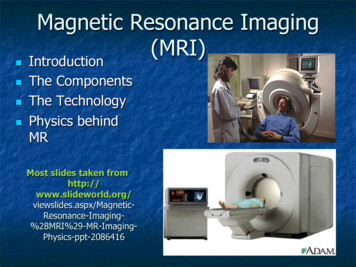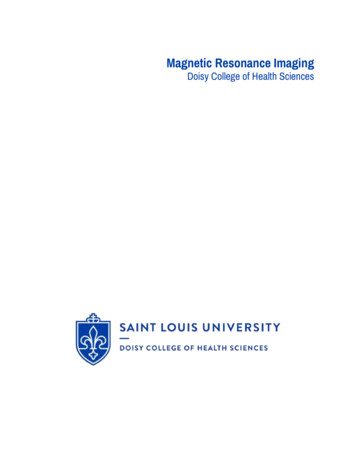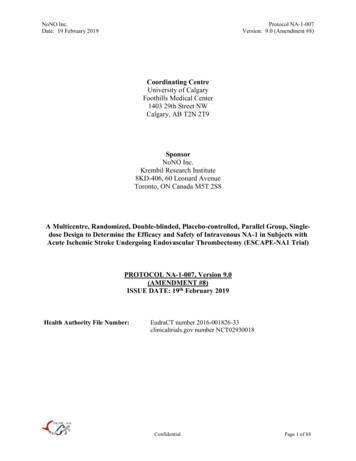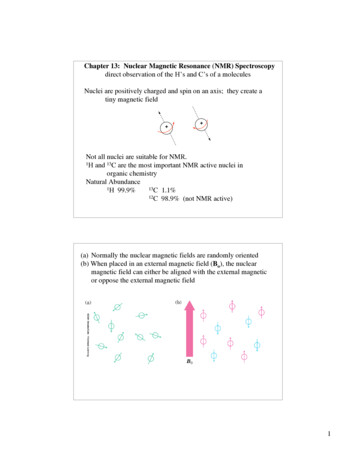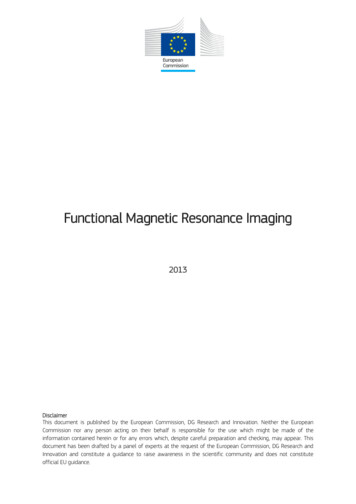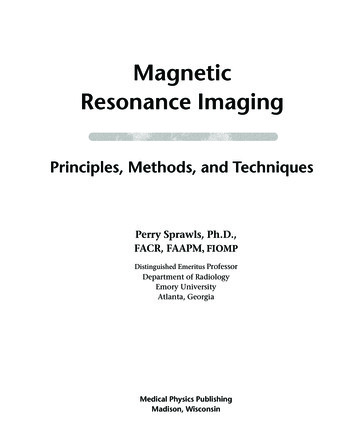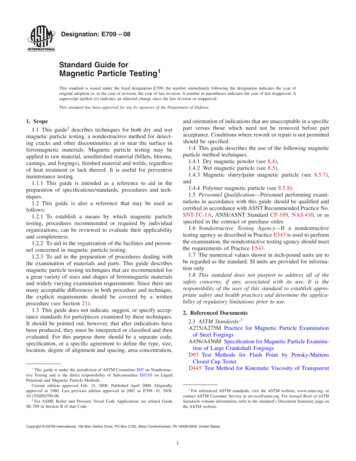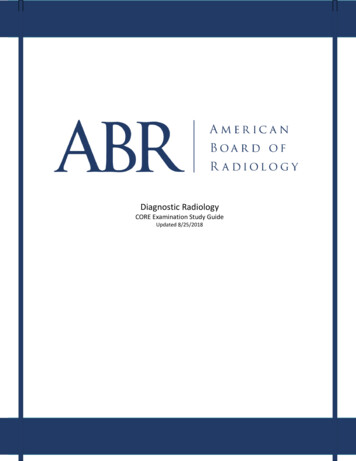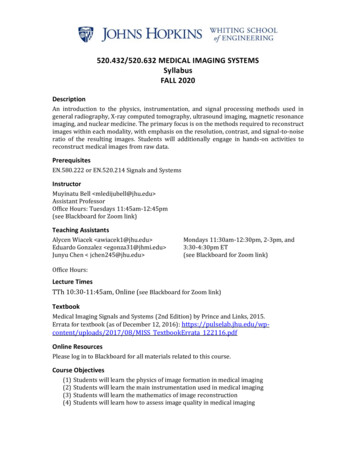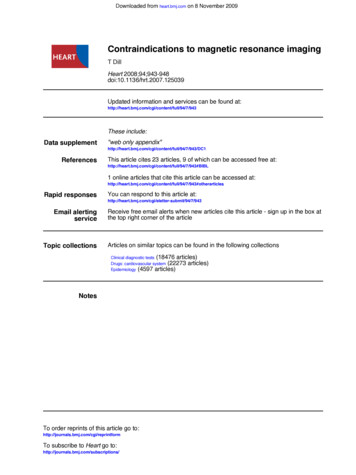
Transcription
Downloaded from heart.bmj.com on 8 November 2009Contraindications to magnetic resonance imagingT DillHeart 2008;94;943-948doi:10.1136/hrt.2007.125039Updated information and services can be found hese include:Data supplement"web only 7/943/DC1ReferencesThis article cites 23 articles, 9 of which can be accessed free BIBL1 online articles that cite this article can be accessed otherarticlesRapid responsesYou can respond to this article 3Email alertingserviceTopic collectionsReceive free email alerts when new articles cite this article - sign up in the box atthe top right corner of the articleArticles on similar topics can be found in the following collectionsClinical diagnostic tests (18476 articles)Drugs: cardiovascular system (22273 articles)Epidemiology (4597 articles)NotesTo order reprints of this article go to:http://journals.bmj.com/cgi/reprintformTo subscribe to Heart go to:http://journals.bmj.com/subscriptions/
Downloaded from heart.bmj.com on 8 November 2009Education in HeartNON-INVASIVE IMAGINGContraindications to magneticresonance imagingT Dillc Additional references arepublished online only at t of Cardiology/Cardiovascular Imaging,Kerckhoff Heart Center, BadNauheim, GermanyCorrespondence to:Thorsten Dill, MD, Departmentof Cardiology/CardiovascularImaging, Kerckhoff Heart Center,Benekestrasse 2-8, 61231 BadNauheim, Germany; t.dill@kerckhoff-klinik.deMagnetic resonance imaging (MRI) is a methodthat has evolved continuously during the past20 years, yielding MR systems with stronger staticmagnetic fields, faster and stronger gradientmagnetic fields, and more powerful radiofrequencytransmission coils. It is increasingly being used andrequested as several new indications have beenestablished during the last few years—for example,cardiovascular MRI.To evaluate the contraindications to MRI isequivalent to understanding the safety issuessurrounding the use MRI.MRI is often described as a ‘‘safe’’ modality dueto the fact that, unlike x ray based systems,ionising radiation is not involved. However, thereare hazards intrinsic to the MR environment thatmust be acknowledged and excluded. Mostreported cases of MR related injuries and the fewfatalities that have occurred have apparently beenthe result of failure to follow safety guidelines orhave resulted from the use of inappropriate oroutdated information related to the safety aspectsof biomedical implants and devices. Therefore, forinformation on specific guidelines and devices,detailed sources of safety information—for example, dedicated websites (box 1)—are recommended.1 2 w1 w2Risks associated with MRI may be attributed toone or to a combination of the three mainmechanisms of the system:1.2.Strong static magnetic fields—As a result offerromagnetic interactions, an object or devicemay be moved, rotated, dislodged, or accelerated toward the magnet. The ‘‘projectileeffect’’ means that, depending on the type ofmagnet and the intensity of the generatedfield, to varying extent, objects are attracted tothe centre of the magnet (for example, heliumor oxygen cylinders, ventilators, wheelchair,etc), possibly causing severe injuries anddamage. Furthermore, articles such as metallicsplinters, vascular clips, and cochlear implantsmay be dislodged. The strong magnetic fieldmay also affect device function, as most, butimportantly not all, currently implanteddevices are either non-ferromagnetic or weaklyferromagnetic.Pulsed gradient magnetic fields—Gradients aretime-varying magnetic fields used to encodefor various aspects of the image acquisition.They are much weaker than the main magnetic field. As they are repeatedly and rapidlyHeart 2008;94:943–948. doi:10.1136/hrt.2007.1250393.turned on and off the rapid changing magneticfields can induce electrical currents in electrically conductive devices and may directly causeneuromuscular stimulation.Pulsed radiofrequency fields—The main biological effects of radiofrequency fields is theirthermogenic effect. Some of the applied energywill be absorbed by the body and convertedinto heat. The specific absorption rate (SAR,expressed in watts/kilogram) increases withthe square of the field strength and varies withdifferent sequences. Metallic devices (for example, pacer leads) can concentrate radiofrequency energy which leads to local heating.Radiofrequency energy can also induce electrical currents in wires and leads which mightinduce arrhythmias.The US Food and Drug Administration (FDA)has approved brief exposure to magnetic fields atall of the intensities currently in use for clinicalpurposes (from 0.2 to 3.0 Tesla (T), and even up to8 T for research) on the grounds that is notharmful to the body, but this is only true forpatients in general. Patients with cardiovasculardevices, in particular, have to be evaluated carefully.3 4Recently, another potential hazard has comeinto the focus, namely, nephrogenic systemicfibrosis attributed to the administration of gadolinium based MR contrast agents in patients withrenal failure.5With increasing numbers of cardiovascular MRIundertaken for ischaemia testing using eitheradenosine or dobutamine for pharmacologicalstress, contraindications to the administration ofthese substances have to be taken into account.Patient screening before an MR examination ismost effective to prevent adverse events.1 6 w3Therefore, a checklist with possible contraindications appears to be useful. An example of such achecklist is given in box 2.This article will summarise current recommendations on safety and resulting contraindicationsfor MRI.METALLIC IMPLANTSVascular clipsIf a clip is made of non-ferromagnetic material andif there are no concerns with MR associatedheating, a patient may undergo MR immediatelyafter implantation.4 For endocranial clips, a writtencertification from the neurosurgeon is required7; if943
Downloaded from heart.bmj.com on 8 November 2009Education in HeartBox 1 Relevant websites with additional informationcccccAmerican College of Radiology. ACR practice guidelines for the performanceof cardiovascular MRI: http://www.acr.orgFood and Drug Administration recommendations. Center for Devices andRadiological Health. MDR data files: www.fda.gov/CDRH/mdrfile.htmlMRI safety. Institute for Magnetic Resonance Safety, Education, andResearch: http://www.MRIsafety.com. or http://www.IMRSER.orgNorth American Society for Cardiac Imaging: http://www.nasci.org.Society for Cardiovascular Magnetic Resonance: http://www.scmr.orgthe clip is made of titanium or titanium alloy, theexamination can be performed.w4 w5 However, ifthe clip is declared to be ferromagnetic or otherwise incompatible with MR, the examination mustbe cancelled. In general, MR compatible materialshave been increasingly used since the mid 1990s, sothe risk of incompatibility is quite low but needs tobe checked.Foreign bodiesThe potential danger of a metal foreign body—forexample, a metallic splinter in the eye—has beenreported since MR was first introduced for clinicalpurposes.w6 If there is any doubt about the presenceor location an x ray should be taken before the MRI.The same holds true for bullets or grenade fragments.w7 w8 Shifting of metal foreign bodies under theinfluence of the magnetic field could damage vitalstructures—for example, vessels or nerves. It is anindividual decision if the risk of an MR examinationis outweighed by the benefit of an investigation.Surgical sutures are made of various metallic andnon-metallic materials and sometimes induce artefacts. The most widely used types in clinical practicehave been tested at magnetic fields of 1.5 T and 3 Tand were found to be safe for MRI.8 w9Coronary and peripheral artery stentsMost coronary artery and peripheral vascular stentsare made of stainless steel or nitinol. Some stentsmay be composed of, or contain, variable amounts ofplatinum, cobalt alloy, gold, tantalum, MP35N, orother materials.1 That means most coronary andperipheral vascular stents are non-ferromagnetic orweakly ferromagnetic. Extensive studies have led tothe conclusion that MR scanning of patients afterstent implantation can be performed without risk atany time at 3 T or less.4 There is no risk ofdislodgement as implantation against the vessel wallprovides sufficient stability and no increased risk foracute stent thrombosis (for bare metal stents as wellas drug eluting stents (DES).9 w10 w11 The effect ofheating induced by the radiofrequency field on thepolymer of DES is unknown. However, stentsgenerally cause artefacts that impair evaluation ofthe stent itself.Aortic stent graftsThe majority of endovascular aortic stent grafts arenon-ferromagnetic or weak ferromagnetic and may944be scanned immediately after implantation at 3 Tor less. It is important to mention that there areexceptions8 and scanning cannot be recommendedfor three particular stent grafts.4Prosthetic heart valves and annuloplasty ringsAlthough prosthetic heart valves and annuloplastyrings are made from a variety of materials,numerous studies have demonstrated that MRIexaminations are safe. Even mechanical heartvalves that are composed of a variety of metalsare not a contraindication for MR imaging at 3 Tor less any time after implantation.4 10 w12Depending on the amount of metal contained,there are some minor interactions with themagnetic field, but the resulting forces are muchless compared to those of the beating heart andpulsatile blood flow.Sternal wires are usually made of stainless steelor alloy and are not a contraindication to MRI.4Cardiac occluder devicesDevices for closure of persistent foramen ovale,atrial septal defect or left atrial appendage areusually made of non-ferromagnetic material (titanium, nitinol), the few made of stainless steelbeing weakly ferromagnetic. For those with nonferromagnetic material MR imaging can be performed at 3 T or less any time after implantation;for those with weakly ferromagnetic materialwithout the urgent need for an MRI examinationan interval of 6 weeks is recommended.4 11 w13Vena cava filters and embolisation coilsNeither studies in animals nor in man withimplanted inferior vena cava (IVC) filters haveshown filter displacement or any other complication due to MRI examination at 1.5 T or less.Older, weakly ferromagnetic filters should not beimaged before 6 weeks after implantation.4Earlier embolisation coils are made of stainlesssteel and consequently are weakly ferromagnetic,while recent coils are made from platinum or otheralloy and are non-ferromagnetic. Both types ofcoils have been tested and found to be safe forMRI. It is recommended that for the weaklyferromagnetic coils an MRI examination shouldbe deferred until 6 weeks after implantation.4Haemodynamic monitoring and temporary pacingdevicesPulmonary artery monitoring catheters and temporary transvenous pacing leads contain nonferromagnetic but electrically conductive material.During an MRI examination radiofrequency pulsesmight induce currents that could lead to thermalinjuries.12 w14 Therefore, it is a contraindication toexamine patients with such catheters by MRI. Todate there is no report that pulmonary arterycatheters without electrically conductive materialand epicardial pacing leads have caused complications. Thus, scanning of such patients is possiblebut should be done under careful supervision.4Heart 2008;94:943–948. doi:10.1136/hrt.2007.125039
Downloaded from heart.bmj.com on 8 November 2009Education in HeartBox 2 Example of a check list with potential contraindications to an MRIexaminationIf any of the following is checked, evaluation of the individual risk has to beperformed before the MRI examinationc Aneurysm clip(s)c Any metallic fragment or foreign bodyc Coronary and peripheral artery stentsc Aortic stent graftc Prosthetic heart valves and annuloplasty ringsc Cardiac occluder devicesc Vena cava filters and embolisation coilsc Haemodynamic monitoring and temporary pacing devices, eg, Swan–Ganzcatheterc Haemodynamic support devicesc Cardiac pacemakerc Implanted cardioverter-defibrillator (ICD)c Retained transvenous pacemaker and defibrillator leadsc Electronic implant or device, eg, insulin pump or other infusion pumpc Permanent contraceptive devices, diaphragm, or pessaryc Cochlear, otologic, or other ear implantc Neurostimulation systemc Shunt (spinal or intraventricular)c Vascular access port and/or catheterc Tissue expander (eg, breast)c Joint replacement (eg, hip, knee, etc)c Any type of prosthesis (eg, eye, penile, etc)c Tattoo or permanent makeupc Known claustrophobiac Body piercing jewelleryc Hearing aidc Renal insufficiencyc Known/possible pregnancy or breast feedingModified from: Shellock FG, Crues JV. MR procedures: biologic effects, safety,and patient care. Radiology 2004;232:635–52.External pulse generators have not been assessedfor their MRI safety and should not be used in theMR environment.Haemodynamic support devicesDevices such as intra-aortic balloon pumps and leftand right ventricular assist devices have not beenevaluated in regard to MRI safety. However, thefact that they contain ferromagnetic materials,moving parts and electrical components lead to therecommendation that MRI is contraindicated.4Permanent cardiac pacemakers and implantablecardioverter-defibrillatorsThere is great controversy related to the question as towhether MRI in patients with permanent cardiacpacemakers and implantable cardioverter-defibrillators(ICDs) is contraindicated or not.13 14 w15–20 The fact thatthere is an estimated likelihood of 50–75% that apatient with a pacemaker or an ICD will have aclinical indication for MRI scanning during thedevice’s lifetime illustrates that this issue is ofgreat relevance, because numbers of both MRIexaminations and implantable cardiac devices areincreasing.w15 However, there are a variety ofHeart 2008;94:943–948. doi:10.1136/hrt.2007.125039mechanisms by which MRI can affect pacemakers and ICDs. The devices are made of metalof varying ferromagnetic qualities and complexelectrical systems and at least one lead isimplanted into the myocardium. The potentialfor device dislodgement, programming changes,asynchronous pacing, activation of antitachycardiac therapies, inhibition of pacing output, andinduced lead currents that could result in heatingand cardiac stimulation has led to concernsregarding the performance of MR examinationsin patients with permanent pacemakers andICDs.4 Clinical data are limited, with most existingstudies relating to non-cardiac scanning of pacemakers at low field strengths. Moreover, clinicallyused field strengths have increased to 3 T withcurrently unknown device interactions.w21 Further,MRI of pacemaker and ICD patients is contraindicated by MRI manufacturers because of seriousconcerns about tissue damage, induced arrhythmias and electromagnetic compatibility. An FDAstatement summarised that the risks have not yetbeen characterised and mitigated sufficiently tojustify the routine use of MRI examinations inpatients with pacemakers and ICDs.15 w18The current recommendations on safety ofmagnetic resonance imaging in patients with cardiovascular devices state that the studies published inwhich patients with permanent pacemakers andICDs have been scanned safely were conducted invery experienced centres. It is important to note thatthe number of patients with adverse events isunknown, and therefore implanted pacemakersand ICDs should still be considered a strong relativecontraindication to routine MRI and is discouraged.4Under special circumstances, if there is no otherdiagnostic tool available and the potential benefit forthe patient outweighs the risk, MRI might beperformed in an experienced centre with expertisein MRI and cardiology.16 In recent years technological developments have led to a substantial reductionin the proportion of ferromagnetic material insidepacemakers, resulting in considerably reduced sensitivity to electromagnetic interference,w22 and industry efforts to manufacture MRI compatible devices iscontinuing.Matters to take into consideration for patientswith pacemakers and ICDs are listed in box 3.Retained transvenous pacemaker and defibrillatorleadsFollowing the removal of a patient’s pacemaker orICD, transvenous or epicardial electrodes might beleft in situ, for several clinical reasons. Forepicardial leads for temporary pacing after surgeryit has been reported that no cardiac symptoms andno changes on the ECG appear.w23 Epicardial leadsfor an ICD have not been addressed in studies sofar and pose a contraindication. MRI examinationin patients with retained transvenous leads isdiscouraged because, as for patients withimplanted pacemakers or ICDs, there is a risk ofheating and excitation. Fractured leads are acontraindication for MRI.945
Downloaded from heart.bmj.com on 8 November 2009Education in HeartBox 3 Considerations for patients with permanent pacemakers/implanted cardioverter-defibrillators (ICD)Indicationc Inability to adequately assess patient with other diagnostic techniquesc Dedicated informed consent relating to potential risksPatient assessmentc Underlying cardiac rhythmc Time since device implantationc Body part to be scanned and imaging sequences to be usedc Magnet field strengthDevice informationc Device location, type, pre-scan function and programming, leads, batteryvoltagec Patient: non-pacemaker dependent or pacemaker dependent (in this caseasynchronous pacing with avoidance of chest or abdomen scanning)c ICD device programmed to: antitachycardic therapy, pacing, cardioversion anddefibrillation offc Physician experienced in device programming on siteMonitoringc Continuously monitoring of consciousness, heart rate, blood pressure, andoxygen saturationc Visual and acoustic contact throughout the procedure with the patientc Instruction of the patient to report any unusual sensations or problemsc Ability for immediate scan termination and evacuation of the patient from thescannerc Staff trained in advanced cardiac life supportPost-MRIc Evaluation of device function and eventually reprogrammingModified from: Shinbane JS, Coletti PM, Shellock FG. MR in patients withpacemakers and ICDs: defining the issue. J Cardiovasc Magnetic Resonance2007;9:5–13.Permanent contraceptive devicesIntrauterine contraceptive devices are made ofeither non-ferromagnetic material (plastic) or weakferromagnetic material (metal components, typically with copper). Therefore, heating and displacement might be the consequence of MRI.However, the results of various studies indicatethat these devices are safe when patients areexamined using magnets of 1.5 T or less.17 w24 Forinformation on a specific product, reference shouldbe made to the manufacturer’s information and todedicated websites (box 1). The same holds true fordiaphragms used for contraceptive purposes asthey contain metal rings to keep them in position,some of which are made of ferromagnetic materials. It is a general recommendation to inform thepatient that displacement of the device might haveoccurred following the procedure, with consequently inappropriate anti-contraceptive effects.Therefore, the correct position of the device shouldbe checked by ultrasound after the intervention.Cochlear implantsCochlear implants are an accepted means oftreating profound bilateral deafness by directelectrical stimulation of the auditory nerve. Thesesystems consist of complex electric and metalcomponents. Various systems are in use and the946implantation numbers are increasing. This makesthe compatibility of cochlear implants with MRIan increasingly relevant topic. Numerous deviceshave been tested for MRI safety.1 In general it ismost important to know precisely which implantis present and the intended MRI procedure. Forceand torque induced by the magnetic field of theMRI represent a hazard for the implant. Thus,cochlear implants represent a relative contraindication to MRI and only after careful evaluation ofthe individual risk can an MRI possibly beperformed.w25OTHER POTENTIAL CONTRAINDICATIONSTattoos and cosmeticsBoth tattoos and cosmetics may contain particlesof iron oxides or other metals that, by interactingwith the magnetic field, can cause sensations ofheat, burns, swelling or local irritation during anMRI examination.18 w26 If possible cosmetics shouldbe removed before scanning. The same holds truefor piercing material. If removal is not possible anicepack/cold compress may be used. In a review ofthe literature Shellock concludes that neithertattoos nor cosmetics are a contraindication forMRI, provided that appropriate precautions aretaken.19ClaustrophobiaClaustrophobic reactions happen in 1–15% of allpatients who undergo an MR examination andconsequently cannot be imaged or require sedation.The extent of claustrophobia is very variable anddepends on the type of scanner, position in thescanner, gender, and age. When a patient reportsthat he or she is suffering from claustrophobia ithas to be taken seriously; besides the possibleoption of sedating the patient, the incidence ofclaustrophobia can be reduced by a factor of threeby using recently developed scanners with a conicalshaped short magnet bore and reduced acousticnoise.20Pregnancy and postpartumDiagnostic imaging might be required duringpregnancy for several reasons. MRI has been usedto evaluate obstetric, placental, and fetal abnormalities in pregnant patients for many years.21 w27The existing safety issues are related to possibleadverse biological effects by the magnetic fields.Many research investigations have been conductedto determine the effects of MRI during pregnancy.The guidelines for MR in pregnant patients state:‘‘MRI may be used in pregnant women if othernon-ionizing forms of diagnostic imaging areinadequate or if the examination provides important information that would otherwise requireexposure to ionising radiation (eg, fluoroscopy,computed tomography). Pregnant patients shouldbe informed that, to date, there has been noindication that the use of clinical MR imagingduring pregnancy has produced deleteriouseffects.’’ For clinical use this means that theHeart 2008;94:943–948. doi:10.1136/hrt.2007.125039
Downloaded from heart.bmj.com on 8 November 2009Education in Heartindividual case has to be evaluated and if thediagnostic information outweighs concerns aboutpotential negative effects, the MRI examinationcan be performed with oral and written informedconsent provided.19 w28dimeglumine or gadoversetamide in pregnantwomen exist.w29–32 The fact that the chelate ofgadolinium remains in the amniotic fluid, and thegadolinium ion could dissociate from the chelate(which would be toxic), underlines that administration of contrast agent should be handled in ahighly restrictive manner. Paramagnetic contrastmedia are filtered and eliminated by the kidneys;however, the mammary gland can also contributeto their excretion to a small extent, and so breastmilk may contain an extremely small amount ofcontrast medium. The amount of medium transferred via breast milk is over 100 times less than themaximum intravenous gadolinium dose recommended for neonatal use, the intestinal absorptionof ingested gadolinium is extremely small (0.04–0.08% of the amount ingested), and the absorbedamount is rapidly excreted by the kidneys.23 w33 Onthe basis of these findings, breast feeding can becontinued without reservation after the administration of paramagnetic contrast media to themother.21MRI AND CONTRAST AGENTRenal insufficiencyToday, MR contrast media are administered in 40–50% of all MRI examinations.22 With increasingnumbers of indications for MRI (for example,cardiovascular MRI, MR angiography) the proportion of examinations with usage of contrast agentwill further increase. Therefore, it is important toassess each patient’s individual risk from contrastadministration before starting the examination.Nephrogenic systemic fibrosis (NSF) is a sclerosingdisorder found in patients with impaired renalfunction after MRI examinations with gadoliniumbased contrast agents (GBCA); symptoms usuallydevelop up to 4 weeks after exposure.5 NSF ischaracterised clinically by symmetric, coalescing,indurated dermal plaques most typically found onthe extremities, particularly the lower legs andforearms, although fibrosis may be found in otherorgans (for example, striated muscle, myocardium,lungs, and dura mater).5 w34–36The exact mechanism for the development ofNSF remains uncertain. GBCA are renally eliminated and so all patients with impaired renalfunction are at risk of retaining GBCA afterexposure. NSF affects only patients with renalinsufficiency and some cofactors are under discussion—for example, previous major surgery, deepvein thrombosis, or metabolic acidosis. The currentrecommendations state that the use of GBCA isstrongly discouraged in patients with glomerularfiltration rates of ,30 ml/min, in any patient withhepato-renal syndrome, or in liver transplantrecipients.24 Even haemodialysis 12 h or more afterGBCA exposure does not protect from the development of NSF.25 There seem to be differencesbetween the currently approved GBCA in regard totheir potential to cause NSF.5MRI contraindications: key pointscccIt is necessary to update continuously knowledge regarding the safety issuesrelated to MR technology, as well as to the technology of implants, devices,contrast agents, and other aspects related to the magnetic resonance imaging(MRI) examination.MRI has become an increasingly used imaging modality in many fields ofmedicine, including cardiovascular imaging; therefore, careful patientscreening before the examination, accurate evaluation of the individual risk,and qualified patient supervision is mandatory.Most reported cases of MR related injuries and the few fatalities that haveoccurred have apparently been the result of failure to follow safety guidelinesor from the use of inappropriate or outdated information related to the safetyaspects.Paramagnetic contrast media during pregnancy andbreast feedingAlthough gadolinium containing contrast mediacross the placental barrier, no published dataof teratogenic or mutagenic effects on thefetus related to the administration of gadopentetate dimeglumine, gadoteridol, gadobenateYou can get CPD/CME credits for Education in HeartEducation in Heart articles are accredited by both the UK Royal College ofPhysicians (London) and the European Board for Accreditation in Cardiology—you need to answer the accompanying multiple choice questions (MCQs). Toaccess the questions, click on BMJ Learning: Take this module on BMJLearning from the content box at the top right and bottom left of the onlinearticle. For more information please go to: http://heart.bmj.com/misc/education.dtlc RCP credits: Log your activity in your CPD diary online .asp)—pass mark is 80%.c EBAC credits: Print out and retain the BMJ Learning certificate once you havecompleted the MCQs—pass mark is 60%. EBAC/ EACCME Credits can now beconverted to AMA PRA Category 1 CME Credits and are recognised by allNational Accreditation Authorities in Europe (http://www.ebac-cme.org/newsite/?hit men02).Please note: The MCQs are hosted on BMJ Learning—the best available learningwebsite for medical professionals from the BMJ Group. If prompted, subscribersmust sign into Heart with their journal’s username and password. All users mustalso complete a one-time registration on BMJ Learning and subsequently log in(with a BMJ Learning username and password) on every visit.Heart 2008;94:943–948. doi:10.1136/hrt.2007.125039CONCLUSIONIt is necessary to update continuously our knowledge regarding the safety issues related to MRtechnology, as well as to the technology ofimplants, devices, contrast agents, and otheraspects related to the MRI examination. MRI hasbecome an increasingly used imaging modality inmany fields of medicine; therefore, careful patientscreening before the examination, accurate evaluation of the individual risk on the basis of current947
Downloaded from heart.bmj.com on 8 November 2009Education in Heartrecommendations (refer to dedicated websites orliterature), and qualified patient supervision ismandatory.11.Competing interests: In compliance with EBAC/EACCME guidelines, all authors participating in Education in Heart have disclosedpotential conflicts of interest that might cause a bias in the article.The author has no competing 810.Shellock FG. Reference manual for magnetic resonance safety,implants, and devices, 2006 ed. Los Angeles: Biomedical ResearchPublishing, 2006.Extensive overview of MRI compatibility of implants anddevices.Shellock FG. Pocket guide to MR procedures and metallic objects:update 2001. Philadelphia: Lippincott Williams & Wilkins, 2001.Prasad SK, Pennell DJ. Safety of cardiovascular magneticresonance in patients with cardiovascular implants and devices.Heart 2004;90:1241–4.Levine GN, Gomes AS, Arai AE, et al. Safety of magneticresonance imaging in patients with cardiovascular devices: anAmerican Heart Association scientific statement from theCommittee on Diagnostic and Interventional CardiacCatheterization, Council on Clinical Cardiology, and the Council onCardiovascular Radiology and Intervention. Endorsed by theAmerican College of Cardiology Foundation, the North AmericanSociety for Cardiac Imaging, and the Society for CardiovascularCardiology Magnetic Resonance. Circulation 2007;116:2878–91.Recently published comprehensive scientific statementsummarising safety issues for MRI in patients withcardiovascular devices.Cowper SE. Nephrogenic systemic fibrosis: an overview. J AmColl Radiol 2008;5:23–8.Excellent summary of the current knowledge onnephrogenic system
the clip is made of titanium or titanium alloy, the examination can be performed.w4 w5 However, if the clip is declared to be ferromagnetic or other-wise incompatible with MR, the examination must
